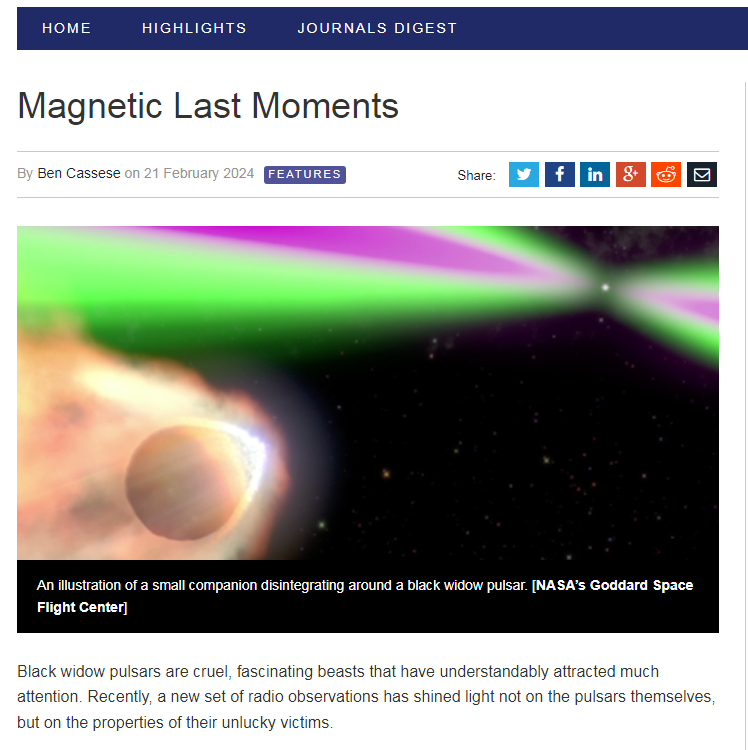搜索结果: 1-15 共查到“理学 NOvA”相关记录31条 . 查询时间(0.062 秒)

中国科学院新疆天文台脉冲星研究团组科研成果入选(AAS) Nova网站亮点新闻(图)
脉冲星 分析 磁场
2024/4/20
2024年2月底,新疆天文台脉冲星研究团组王双强副研究员科研成果文章《Change of Rotation Measure during the Eclipse of a Black Widow PSR J2051-0827》(ApJ, 2023, 955, 36)被美国天文学会(AAS) Nova网站遴选为研究亮点,以“Magnetic Last Moments”为题在网站头条报道,同步转载AA...
Iowa State physicist analyzes first electron neutrino data from NOvA Experiment
Iowa State physicist first electron neutrino data NOvA Experiment
2016/4/25
Mayly Sanchez clicked to a presentation slide showing the telltale track of an electron neutrino racing through the 14,000-ton Far Detector of the NOvA Neutrino Experiment.Since that detector sta...
ULF geomagnetic field measurements in Antarctica are a very important tool for better understanding the dynamics of the Earths magnetosphere and its response to the variable solar wind conditions. We ...
Unprecedented nova images illuminate astronomers' models for its ejecta
astronomy image fireball stage
2014/10/30
The first images of a nova during its early fireball stage--when it ejects material, and gases expand and cool--show that this activity is more complicated than predicted.

Highly-detailed radio-telescope images have pinpointed the locations where a stellar explosion called a nova emitted gamma rays, the most energetic form of electromagnetic waves. The discovery reveale...

Scientists on the world's longest-distance neutrino experiment announced today that they have seen their first neutrinos.
The Orbital Period and Variability of the Dwarf Nova ES Draconis
stars: individual: ES Dra (PG 1524+622) – novae: cataclysmic variables – binaries: spectroscopic – AAVSO
2011/10/12
A radial velocity study of the cataclysmic variable ES Dra (PG 1524+622) is presented. ES Dra is found to have an orbital period of 0.17660 \pm 0.00006 d (4.2384 \pm 0.0014 h). The mass-losing seconda...
EVLA Nova Project Observations of the Classical Nova V1723 Aquilae
Project Observations Classical Aquilae
2011/10/8
We present radio light curves and spectra of the classical nova V1723 Aql obtained with the Expanded Very Large Array (EVLA). This is the first paper to showcase results from the EVLA Nova Project, wh...
Quark nova imprint in the extreme supernova explosion SN 2006gy: the advent of the Quark Star
Quark nova imprint the extreme supernova explosion SN 2006gy
2011/1/11
The existence of quark stars has until now been purely hypothetical. In this work, we uncover undeniable evidence of these exotic objects with far reaching implications to various branches of physics ...
The orbital and superhump periods of the dwarf nova HS 0417+7445 in Camelopardalis
bital and superhump periods Camelopardalis
2010/11/11
We present the 2005–2010 outburst history of the SUUMa-type dwarf HS 0417+7445,along with a detailed analysis of extensive time-series photometry obtained in March 2008 during the second recorded supe...
The 2010 nova outburst of the symbiotic Mira V407 Cyg
Stars novae – Stars symbiotic stars – Miras
2010/11/10
The nova outburst experienced in 2010 by the symbiotic binary Mira V407 Cyg has been extensively studied at optical and infrared wavelengths with both photometric and spectroscopic observations. This ...
A modeling study of heterogeneity and surface water-groundwater interactions in the Thomas Brook catchment, Annapolis Valley (Nova Scotia, Canada)
A modeling study heterogeneity surface water-groundwater interactions
2009/9/11
A modelling study of the impacts of subsurface heterogeneity on the hydrologic response of a small catchment is reported. The study is focused in particular on the hydraulic connection and interactio...
Quark-Nova Explosion inside a Collapsar:Application to Gamma Ray Bursts
Quark-Nova Explosion Collapsar Gamma Ray Bursts
2009/9/4
If a quark-nova occurs inside a collapsar, the interaction between the quark-nova ejecta (relativistic iron-rich chunks) and the collapsar envelope leads to features indicative of those observed in Ga...
New spectroscopic observations of dwarf nova BZ ursae Majoris with extremely unusual emission lines profiles
spectroscopic observations dwarf nova BZ ursae Majoris
2009/6/17
New spectroscopic observations of dwarf nova BZ ursae Majoris with extremely unusual emission lines profiles。
Spectroscopy of old nova candidates。

